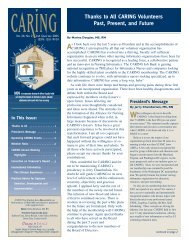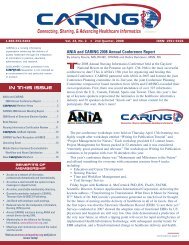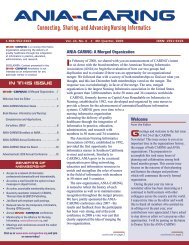Download - American Nursing Informatics Association
Download - American Nursing Informatics Association
Download - American Nursing Informatics Association
You also want an ePaper? Increase the reach of your titles
YUMPU automatically turns print PDFs into web optimized ePapers that Google loves.
Photo courtesy of Karl Oyri<br />
One Size Does Not Fit All: An Initiative to Improve Pediatric<br />
Patient Safety at Children’s National Medical Center<br />
By Susan Stanley, MSN, RN<br />
Long ago in the land of babes, a techno-savvy group of nurses began<br />
questioning the lack of well fitting armbands for the children. “Why do I have to<br />
tape this giant band on my 3 kilogram baby? It always falls off anyway. I’ll just<br />
tape it to the crib – that will work.”<br />
his may sound like a fairy tale, but in reality, properly fitting identification (ID)<br />
Tbands for pediatric patients is a challenge. In order to provide an age-specific<br />
ID band, a team of clinicians at Children’s National Medical Center (CNMC) in<br />
Washington, D.C. developed a task force to develop and implement point of care<br />
access for pediatric ID bands. Sounds simple enough, right? Three arduous years<br />
after the task force began its work, the staff at CNMC is on the verge of the actual<br />
implementation. This article will outline the journey of the CNMC task force to<br />
identify the desired elements and develop a concept of age-specific ID bands, and<br />
the challenges encountered in this process. In a future article, the process of<br />
implementation of the plan as well as lessons learned will be discussed.<br />
Review of Current ID Band Processes<br />
“To help reduce patient identification errors, most hospitals use patient ID<br />
bands that can either be worn on the wrist or ankle” (“Technology in patient<br />
safety,” 2005). At CNMC, the admissions department staff prints a “one size fits<br />
all” ID band during patient registration, and in most cases, applies it to the child’s<br />
wrist. In the Neonatal Intensive Care Unit (NICU), this band is unsuitable, forcing<br />
the nurse or clerk to create a patient ID band by trimming the patient name,<br />
medical record number, and account number from a pre-printed label and affixing<br />
it to a soft band used for neonates. This soft band is then applied to the baby’s<br />
extremity. In the presence of skin fragility, the ID band is secured to the bed. If,<br />
for any reason, the ID band is removed, a new band is requested from admissions<br />
via phone or fax and delivered to the unit with an expected time delay. Temporary<br />
ID bands are available on the inpatient units that require trimming of a pre-printed<br />
patient label to fit on the band. A frequent problem necessitating application of a<br />
replacement band is contact with moisture from the patient directly or from<br />
patient care activities that denigrate the visibility of the patient information on the<br />
band needed for proper identification.<br />
A series of interviews and scheduled demonstrations for band printers and ID<br />
band designs led to selection of a vendor, Zebra Technologies. Our important<br />
selection criteria included:<br />
• Appropriate ID band size choices for pediatric patients<br />
• ID band reprint capability at the point of care<br />
• Ability to upgrade ID bands in the future to include Radio Frequency<br />
Identification (RFID) without need to purchase brand new equipment.<br />
• Thermal printing to maintain water proof integrity of printed ID Band<br />
information<br />
Designing the ID Band Elements<br />
The design of the new band was one of the unexpected challenges for the task<br />
force. Initially, the task force thought it wise to limit the information on the ID<br />
band to patient name, medical record number, and encounter/account number<br />
because a new band would not need to be generated if the patient’s attending<br />
physician changed, or if the patient transferred to another<br />
Page 5 • 4th Quarter 2006<br />
continued on page 6<br />
More Member News<br />
Bytes of Interest<br />
Debbie Harris, Columbia, MD, was featured<br />
in the Howard County General<br />
Hospital publication, Wellness Matters,<br />
Vol.10, No. 4, Winter 2007 in an article<br />
called, “Helping Hand gives a Head<br />
Start.” Debbie is a volunteer for the<br />
Community Action Council of Howard<br />
County serving those in need.<br />
Focus on Military members: CARING<br />
has 38 members currently servicing in<br />
the US Military service. Lori Frank<br />
(Navy) and Angela Stone (Army) are<br />
currently in Iraq. Saturnino “Tony”<br />
Chavez (Army) is stationed in<br />
Wurzburg, Germany. Margaret<br />
Beaubein (Navy) is in Okinawa. We<br />
thank our troops for serving within and<br />
outside of the United States.<br />
Karen S. Martin, Omaha, NE, reports<br />
that an international conference, The<br />
Omaha System: A Key to Practice,<br />
Documentation, and Information<br />
Management, will be held April 12-14,<br />
2007 in Minneapolis-St. Paul, MN.<br />
Details are posted on www.omaha<br />
system.org, The Conference is cosponsored<br />
by Martin Associates and the<br />
University of Minnesota School of<br />
<strong>Nursing</strong>.<br />
Michael J. Sutter, Champaign, IL, was<br />
interviewed and featured in a Health<br />
Management Technology article,<br />
“Clinical Systems are a ‘Go’ in Real<br />
Life.” See http://www.healthmgt<br />
tech.com and select the article from<br />
the January 2007 issue.<br />
Pauline Ellis, MPA, BSN, RN, COHN-S,<br />
CLCP, Lake Ridge, VA died January<br />
2007. She was an active member of<br />
CARING from about 1998 to 2005.<br />
She attended many meetings. In the<br />
2002, Vol. 17 No, 2, CARING<br />
Newsletter, Pauline penned a fascinating<br />
account of Anthrax and the US<br />
Postal service (USPS). She was an<br />
Occupational Health Nurse at the<br />
USPS in Washington, DC and used<br />
information management tools to help<br />
solve healthcare problems - a true<br />
informatics nurse. She also presented<br />
her story at a CARING meeting. Our<br />
condolences go to her family.<br />
Please send items for future newsletters<br />
to: Susan K. Newbold,<br />
snewbold@umaryland.edu







